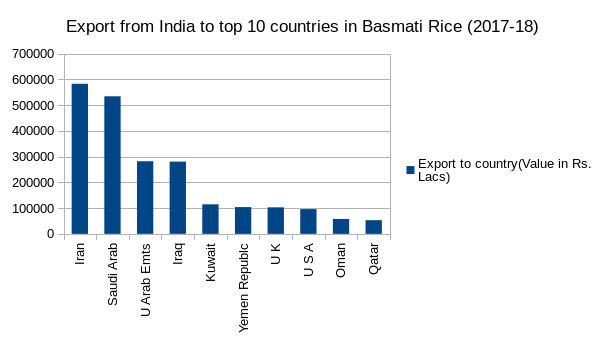About Basmati
1. Globally, India ranks first in acreage (26.6%) and 2nd in production (21.5%) of paddy.In 2009 total arable land for paddy in the world is 158300068 hectare with the total production of 685240469 tonnes of paddy, out of which 41850000 hectare of the area is held by India only, which produced 133700000 tonnes of paddy just second after 196681170 tonnes by China.
2. Rice (including Basmati and Non Basmati) occupy the major share in India's total cereals export with 95.7% during the year 2017-18. Whereas, other cereals including wheat represent only 4.3 % share in total cereals exported from India during this period.
3. Basmati rice constitutes a small portion of the total rice produced in India.(Total rice produced in 2017 111.01 million tonnes. Total basmati produced in 201725 million tonnes).
4. By volume, the share of basmati rice is around 6% in 2014-15, even as by value, basmati rice exports account for 57% in 2014-15, of India's total rice exports.
5. India accounts for over 70% of the world's basmati rice production. India is the leading exporter of the Basmati Rice to the global market.
6. The country has exported 4056758.62 MT of Basmati Rice to the world for the worth of Rs. 26870.17 crores (or 4169.48 US$ Mill.) during the year 2017-18.
7. Major Export Destinations (2017-18) : Iran, Saudi Arab, U Arab Emts, Iraq and Kuwait.

8. In almost all the states, the private seed companies contribute a major share of the seed to the farmers. In Punjab 80-90% and in Haryana 70-80% seed is offered by the small and medium private seed companies and Basmati traders.
9. In Aligarh market area of Uttar Pradesh 100% farmers depend on the tag on seed bag.
References:
1."Basmati rice industry may revive in next harvest 2016-17: Icra".Business Standard. Press Trust of India. April 3, 2016. Retrieved 2018-03-21.
2. http://pib.nic.in/newsite/PrintRelease.aspx?relid=176824
3. Basmati_Crop_survey_Report_6_Season_2018, Basmati Export Development Foundation APEDA, New Delhi.
4. http://apeda.gov.in/apedawebsite/SubHead_Products/Basmati_Rice.htm
5. Report on identity preservation of Basmati Rice at various stages in the Rice Supply Chain, Ministry of Environment Forest and Climate Change.
6. http://www.fao.org/india/fao-in-india/india-at-a-glance/en/
7. Sharma v. et al,(2013) Supply chain management of rice in India: A rice processing company’s perspective. DOI: 10.5121/ijmvsc.2013.4103.
8. http://agriexchange.apeda.gov.in/product_profile/exp_f_india.aspx? categorycode=0601
9. http://apeda.gov.in/apedawebsite/six_head_product/cereal.htm